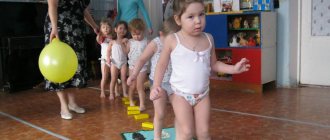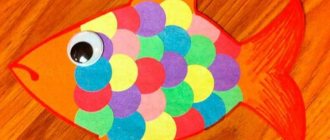Physical exercise is one of the principles of a healthy lifestyle. They are accustomed to them from a very young age. The mother does the first exercises for newborns together with the baby. Morning physical education helps the baby wake up, energizes him for the whole day, strengthens muscles and develops a sense of discipline. However, for gymnastics to really bring benefits and be a joy, you need to follow some rules.
What does morning exercise do for children?
Exercising in the morning has a beneficial effect on the functioning of the whole body. In the case of children, exercise or so-called gymnastics helps them wake up, strengthen their body, improve appetite, speed up metabolic processes, harmonize sleep and much more.
First of all, performing sports exercises instills in a child a desire for discipline and composure, which will be very useful to him in the future in adulthood.
- Moreover, it would seem that such a simple activity develops willpower in a little person, trains the spirit and increases endurance.
- Often, exercises for children are organized in kindergarten. There, trained specialists work with them, who are their educators or special trainers.
- Educators know which movements are suitable for exercise in young children and which are not. This is why the risk of injury is reduced to a minimum.
- However, not all parents send their children to kindergarten. And certainly not everyone adheres to the regime on weekends, when the child takes a break from visiting kindergarten.
- Unfortunately, parents find this activity boring, but what can we say about their kids? However, there is always a way out!
To make the process less boring, choose music to energize your children. Usually these are funny songs from good old Soviet cartoons or more modern melodies.
Music in the background will help your child understand the rhythm, and the lesson itself (even if it only lasts 15 minutes) will take place in a relaxed atmosphere.
Mandatory features of proper charging
So, what is it, correct charging? This concept includes several criteria:
- Gradual: under no circumstances force your child to start with something difficult. For example, do not immediately demand from him a perfect stretch so that when he bends over, he can rest his palms on the floor. The same can be said about the load. Increase it gradually, starting small. However, still do not rush. Before you is a growing, forming organism, work with which must be carried out with special care and caution.
- Systematicity: as in any other matter, regularity is important. That is, follow a specific exercise schedule. Ideally, children should study at the same time every morning. But here who has what opportunities.
- Variety: You should change the exercise program from time to time so that the child's muscles and body adapt to different types of exercise and new neural connections are formed in the brain. Use his favorite toys - do exercises with a ball, jump rope, etc. You can manage to come up with what words you say and what words the child says while doing exercises for children. This will stir up interest and contribute to a fun time.
- Moderation: Avoid overtiring your child. Better less and high quality than fast and nothing at all.
- Accessibility: Remember, this is a small child. You don't need complicated curtsies and plie squats. Simple stretches, turns, bends, squats and jumps are enough.
At what age to start
Up to a year, mother and baby are engaged in what can be called preparation for real gymnastics: exercises for newborns up to a month include stroking and stretching, accompanied by poetry. They give the baby a positive experience from the contact between the mother and his own body.
Then passive gymnastics is added to the general strengthening massage for infants: the mother carefully bends and unbends, brings and spreads the arms and legs of the baby. You can also practice with your baby on a fitball.
Important! Before doing infant gymnastics, consult your pediatrician and take a few lessons from a professional massage therapist.
Kinds
There are several types of charging. Its variety helps to change the type of activity to another and give the child a break if he is tired of one or another exercise or is still finding it difficult.
Fun exercise for children
This activity takes the form of a game and is ideal for children from two to three years old. This age is ideal to start introducing them to sports. At this time, children are extremely restless, so why not channel their energy in the right direction? Moreover, everyone loves games, and they help develop ingenuity and an analytical mind.
Warm-up exercises
This type of sports activity does not mean a full-fledged workout, but a short warm-up, which perfectly helps to cheer up, recover from sleep and tune in for the coming day.
Power charging
Yes, no matter how paradoxical it may sound, children also need to be given a certain load in order to develop their muscles and endurance. The main purpose of this type of exercise is to use certain muscle groups during exercise.
In the case of children, strength exercises include running, lifting toys, jumping, and so on.
Exercise technique
We hold the child’s legs from above, press them against the ball, and the other hand fixes the back. We make soft, rocking movements: back and forth, left and right, circular movements left and right. There is no need to tilt the child forward very much, more emphasis is placed towards the legs. As the child gets used to the ball, the amplitude can be increased. You can also make movements in two planes - back and forth and up and down at the same time. The same movements are performed on the back as on the stomach; they should begin no earlier than 3 months: back and forth, left and right, circular movements in one direction and the other.
- Baby on tummy. We place our hands on the baby's back and lightly press him against the ball. You can hold the baby by the back with your right hand, and use your left hand to fix the left leg in the area of the knee joint. We begin to slowly rock the baby forward, backward, in a circle, so that there is a slight vibration.
- In the same position, rock the baby towards you and away from you, with slight vibration if the baby is already holding his head.
- Baby on the back. We hold it with our hands by the stomach and in the shin area, or you can fix the tummy with your right hand, and the left leg with your left. Slowly, when swinging the ball towards us, we bend the baby’s legs at the knee joints, and when moving the ball away from us, we straighten it. Gently rock the child while lying on his back in a head down position. It’s good if the baby straightens his arms at the same time, this reduces the tone of the flexor muscles. Now we try to perform the same movement, first only with the right leg, then only with the left leg.
- The baby is on his tummy again. We hold his hands and rock him back and forth. Gradually raise the arms extended forward so that the baby lifts his chest away from the ball.
- In the same position, we hold the baby in the lumbar region with our right hand, and with our left we try to put him in the “frog pose”, spreading his knees wide. In this position, we rock forward and backward, creating vibration. This is not only relaxing, but also very beneficial for the development of the hip joints.
While practicing on the ball, talk to your baby, praise him, sing songs or tell jokes. If your child doesn’t like something or is already tired, stop classes and continue another time. The time for practicing on the ball is not strictly regulated. If you and your child enjoy it, do as much as you want throughout the day.
Charging stages
Any physical activity includes several stages:
- Warm up. This stage helps to invigorate and prepare the body muscles for more active exercises. As a rule, it does not take too much time to complete it.
- Warming up To avoid problems during your workout, be sure to warm up with vigorous exercise, such as walking in place or jogging in place. For children, this helps to work out the muscles and tendons of the legs and prevent flat feet.
- The main part consists of more complex exercises that should be aimed at strengthening the muscles.
- Conclusion. Towards the end of the training, the child should switch to easier exercises, such as walking in place. This helps normalize blood pressure, even out breathing and simply relax.
Basic principles of aqua gymnastics
- Comfortable water temperature in the first lessons is 37 - 37.5 degrees, with a decrease in it by 3 degrees until the end of the first month of swimming, and another 2 degrees in the third. For those who are bolder: please remember that the temperature should not fall below 28 degrees - in this case we are talking about hardening.
- The air temperature in the bathroom is 20 - 22 degrees, the door is open. Classes are held 40–60 minutes after feeding and 30 minutes before it.
- Duration of classes - 5 - 20 minutes.
- Water should be without additives (potassium permanganate, essential oils, herbal decoctions, salt), since baths with these additives are therapeutic and are designed for a lying baby, and aqua gymnastics is a set of active exercises with a fairly intense load on the muscles, respiratory, and cardiovascular systems.
- During exercises in water, the baby's ears may become submerged in water; after exercise, do not forget to dry them.
- The duration of classes in water for babies under 4 months in addition to a general massage is about 5 minutes, for older children - up to 10 minutes.
- As an independent type of exercise, aqua gymnastics is carried out for 15 – 20 minutes.
- Contraindications are: open umbilical wound, skin diseases, poor health and mood of the child, acute respiratory viral and other infections in the active phase (exacerbations), acute period of encephalopathy, rapid increase in intracranial hypertension, convulsions, extreme prematurity of children (rapid cooling) and general contraindications related to the purpose of gymnastics and massage.
Recommendations
Before starting classes with children, the following circumstances should be considered:
- You are dealing with a growing, not yet fully formed organism, which has fragile bones, so calculate your strength and do not put a strong load;
- Choose exercises that involve only smooth movements. Avoid harshness;
- Always consider the order of charging steps and do not ignore them;
Even in exercises, be systematic and orderly. That is, start with exercises for the upper body and end with the lower body.









